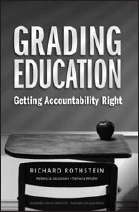Video: author Matt Chingos talks with Education Next
Crossing the Finish Line: Completing College at America’s Public Universities
by William G. Bowen, Matthew M. Chingos, and Michael S. McPherson
Princeton University Press, 2009, $27.95; 392 pages.
In his February address to a joint session of Congress, President Obama announced a new national goal: “By 2020, America will once again have the highest proportion of college graduates in the world…. That is a goal we can meet.”
If he was talking about four-year degrees, we will have to increase degree attainment rates by 1 percent a year over the next decade among the population of 25- to 34-year-olds just to pull even with the current leader for that age group (Norway), and no one expects the rest of the world to stand still while we try to catch up. Our graduation rate will have to rise 1.6 percent a year if the definition of college graduates includes two-year as well as four-year degree holders.
How can we get there from here? A lot of the action will have to be through increasing persistence and completion rates. Enrollment rates among recent high school graduates have shown dramatic gains in recent decades and now approach 70 percent, whereas completion rates have stagnated below 60 percent. It will likely prove much easier to get students who have gained admission to college to the finish line than to boost completion rates among the 30 percent of high school graduates who do not enroll in the first place.
Enter Bowen, Chingos, and McPherson with a Herculean effort to examine the correlates of degree completion at America’s public universities. (Click here to see author Matthew Chingos interviewed by Education Next). Wielding the unique access and influence available to the president emeritus of Princeton University and the Andrew W. Mellon Foundation (Bowen) and the former president of Macalester College and current president of the Spencer Foundation (McPherson), the authors have assembled longitudinal databases on student persistence and completion for 21 of the nation’s flagship public universities, and for the entire state university systems in four states. They’ve obtained data from sources that typically maintain a close hold, e.g., the College Board and the ACT, and linked it to the state and institutional databases, as well as data from the National Student Clearinghouse (used by most higher-education institutions and student loan providers for enrollment and degree verification). In addition, the database on the North Carolina state system includes information on student academic performance beginning in the 8th grade, making it a rich resource for examining how college enrollment and graduation is related to student preparation and characteristics of high schools. That FERPA (the Family Educational Rights and Privacy Act) was probably violated multiple times in assembling this valuable database while no student’s privacy was placed at the slightest risk is a good reason for Congress to rethink laws in this area.
Although the new database is massive and rich, it will be important for readers to be aware that it supports correlational and descriptive rather than causal analyses. The authors have mined their data powerfully within this constraint. For example, we learn that student withdrawal rates at selective public universities occur steadily across the years of enrollment, whereas they are concentrated in the first few semesters at less-selective institutions. This means that retention strategies will need to differ across these types of institutions. We also learn that the predictive power for college graduation of high school grade-point average (GPA) is roughly four times as large as for SAT or ACT scores, and that this relationship holds across different tiers of high schools. This points the way toward institutions being able to serve a broader range of students while simultaneously increasing their completion rates if they adopt admissions policies that focus more on high school achievement and less on tested aptitude.
The authors are on shakier ground when they draw causal inferences. Consider what will likely be a highlight from the book: “The frequently disappointing graduation rate outcomes for students from underrepresented minority groups and for students from low-SES backgrounds are due in no small part [emphasis added] to the fact that a number of them were ‘undermatched.’” By undermatched, the authors mean students who had high school GPAs and SAT or ACT scores that would have made them eligible to attend a more-selective institution than the one they attended. The evidence used to adduce the negative impact of undermatch is that students attending less-selective institutions than they were qualified to attend graduated at lower rates than similar students attending more-selective institutions. The authors try to control for background differences between the undermatched students and their peers in more-selective institutions by adjusting statistically for SAT scores, high school GPA, race/ethnicity, gender, family income, and parental education.
Let’s imagine that these control variables were measured perfectly, even though most required high levels of imputation, e.g., family income and high school GPA were available for only about half of the sample. Think of two students with identical GPAs, SATs, and family socioeconomic status (SES). Both are qualified to attend the University of North Carolina at Chapel Hill (the state flagship). One does, while the other enrolls in Western Carolina University (a much less selective institution). The first student graduates. The second student does not. Why?
The authors would have us believe that the first student graduated because she was surrounded by highly capable classmates, experienced a campus climate in which graduation was expected, had access to superior faculty and facilities, and received more financial aid. They acknowledge “suspicion of a modest [emphasis added] association between enrollment at the most selective flagship universities and unobservable characteristics of entering students, such as ambition and drive.”
Why shouldn’t we suspect that the association between these omitted variables and college graduation is large rather than modest? Why should we think that campus climate, facilities, and faculty have anything to do with the higher graduation rates at more-selective institutions? Researchers Stacy Berg Dale and Alan Krueger, using a national database, found that students who attended more-selective colleges did not graduate at higher rates or earn more in later life than students who were accepted and rejected by comparable schools but attended less-selective colleges.
On this and other points of possible conflict with the existing literature the authors of Crossing the Finish Line choose not to alert the reader or engage in a comparative defense of their work. Nor do they spend much time anticipating and countering likely criticism. Leaving that aside and assuming that their analyses are superior to all others and free from major flaws, we still need prospective controlled studies of the interventions they champion, e.g., reducing undermatch, before it would be prudent to jump on a policy bandwagon. The history of education policy is filled with examples of failed programs and policies that were rushed to scale with no hard evidence of effectiveness.
While Crossing the Finish Line doesn’t provide strong evidence on what will work to increase college graduation rates, it points to four areas that will very likely have to be part of the equation:
Elementary and middle school preparation. The authors found that 8th-grade math and reading achievement scores in North Carolina “are tremendously consequential determinants of subsequent college enrollment patterns,” and that “the level of the high school…matters much less…than most people seem to assume it does.” This suggests that moving college enrollment rates substantially higher will require a continuing and unrelenting focus on improving foundational skills.
Affordability. The authors learn that states with lower levels of tuition in their public colleges and universities have higher attendance rates. This finding joins other research that indicates the importance of price of attendance for students from lower-income families. Policy initiatives in this area are almost all focused on increasing need-based financial aid, and that is the direction taken by the authors. It will also be important to develop policies to rein in costs and increase productivity in higher education lest increases in financial aid always chase increases in tuition.
Retention and on-time graduation. The authors’ case for reducing the leaks and stoppages in the pipeline to graduation is overwhelming. Federal and state incentives at both the institutional and student level for higher on-time graduation rates are needed, as is longitudinal data that would allow institutional graduation rates to include part-time students and those who graduate from institutions other than the one in which they initially enrolled.
Consumer information. Higher education looks like a competitive industry in that there are thousands of institutions from which students can choose. However, in the absence of real information on institutional performance, student choice is frequently uninformed or misinformed. If there are higher labor market returns to a student graduating from Chapel Hill vs. Western Carolina, or majoring in engineering vs. sociology, there should be a web site where that would be evident. If the net price of attendance at a flagship is likely to be lower than at a less-selective institution because of more campus-based aid, that shouldn’t be a mystery. And so on.
Crossing the Finish Line is an essential book for anyone interested in higher education policy. It demonstrates the high value of information locked away in administrative databases, and suggests new and potentially powerful approaches to increasing the nation’s population of college-educated citizens. We’re not likely to again lead the world in the proportion of college graduates unless we figure out how to build on this important foundation.
Russ Whitehurst is senior fellow and director of the Brown Center on Education Policy at the Brookings Institution.






